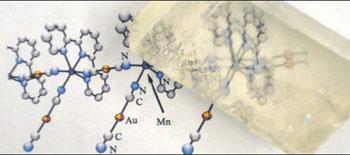Canadian chemists synthesise novel co-ordination polymers with remarkable birefringence
Chemists in Canada have synthesised a new polymer that has a remarkable optical property - it has one of the greatest birefringence values of any solid observed, so that light travelling along the length of the polymer crystals moves at a very different speed from light travelling across them. Birefringence, sometimes called double refraction, is important in a range of applications, from certain types of optical lens to CD readers and optical fibres.
Most birefringent solids are inorganic crystals such as calcite. But Daniel Leznoff and his team at the Simon Fraser University in British Columbia set out to design a polymer with the necessary electronic and geometric properties.

When the researchers crystallised the polymer from solution and measured its birefringence, they were ’shocked,’ Leznoff said. ’At first I didn’t believe the result - and also the figure was beyond our ability to measure it initially,’ he told Chemistry World. The material had a birefringence value - the difference between the refractive indices encountered by light travelling along its two axes - of around 0.4. This compares with a value of 0.17 for calcite - considered to be a highly birefringent crystal.
Molecules forming a birefringent material have different optical properties along their different axes. Such molecules might be long, thin and flat, for example. The Canadian chemists slotted together components of a modular system: a ’terpy’ ligand consisting of three pyridine rings with a metallic centre, either lead or manganese, with these complexes joined together by linear bridging ligands consisting of a central silver or gold ion and two cyanide groups.
’The nice thing about our system is that it is immensely flexible and highly tuneable,’ said Leznoff. ’We have shown what is possible with this approach using co-ordination polymers. We have laid out the recipe for people to think about how to design highly birefringent materials with modular components.’
Commenting on the research, Kim Dunbar at the Texas A&M University in the US said, ’Leznoff and co-workers have demonstrated that the principle of tailoring molecular materials based on coordination compounds, which has already been successful for other important applications such as magnetism, conductivity and photoinduced effects, is a powerful tool in the rational design of other new solids with fascinating properties. Their deliberate introduction of specific units and ligands into the mixed metal coordination polymer produced a fascinating material with unprecedented birefringence behaviour.’
’I predict that we have many more of these important discoveries to look forward to in coordination chemistry,’ Dunbar added.
Simon Hadlington
References
MJ Katz et al., Angew. Chem. Int. Ed., 2007, 46, 8804 (DOI: 10.1002/anie.200702885)






No comments yet